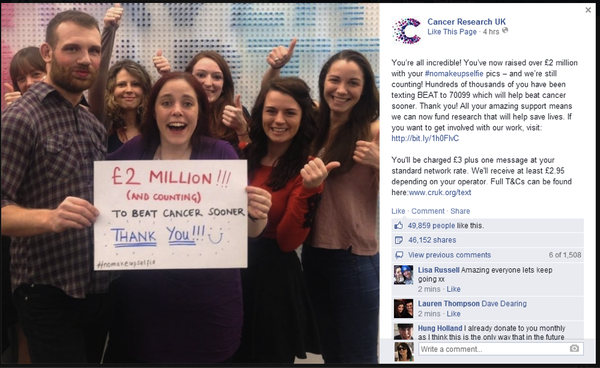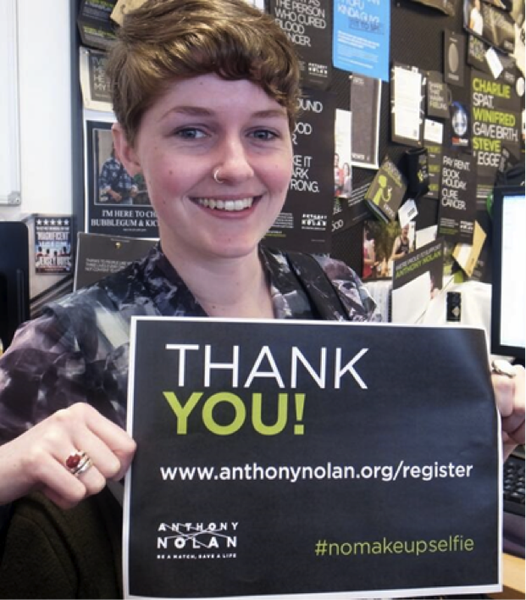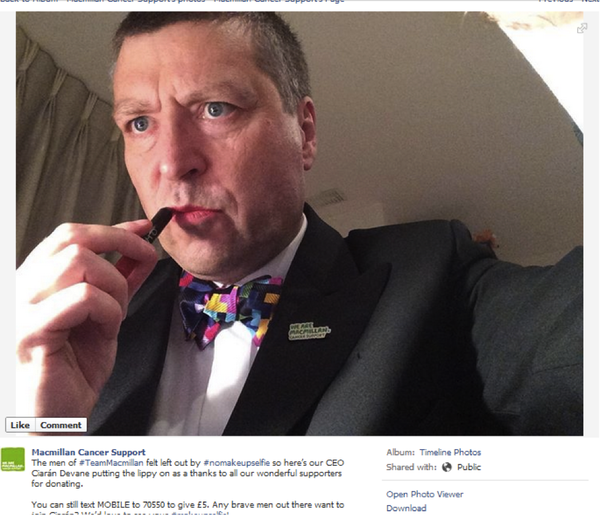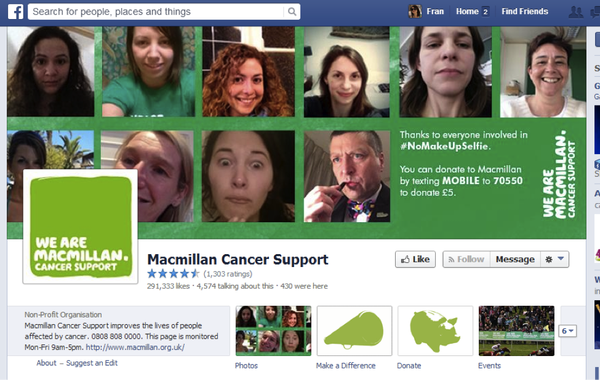Why #nomakeupselfie became popular and what charities can learn from it
It's not yet known exactly how this trend started (but seems to be a spin off from Escentual's Dare to Bare campaign) but it quickly went viral and has had a huge impact on cancer charities all over the UK. As I write, it has currently helped raise over £2million for Cancer Research UK alone. So the question is, why this campaign? Why did #nomakeupselfie go so huge, so fast? This recently became a hot topic on the ECF mailing list and this blog post highlights some of the insights and suggestions raised in that thread.

Image credit: Cancer Research UK
What happened?
- People started posting selfies accompanied with SMS donations to cancer charities.
- Many cancer charities saw a huge spike in donations e.g. Cancer Research UK has currently received over £2million (and counting) in donations and Anthony Nolan have had a 400% increase in donor registrations.
- Cancer charities have also seen a massive increase in social interactions as well as gaining new followers and supporters.
- A spin off trend for men emerged called the #makeupselfie where men posted pictures of themselves wearing makeup.

Image credit: @anthonynolan
What motivated so many women to take part?
The selfie element: It's become an increasingly popular trend for people to take pictures of themselves and acceptable to post them to social platforms without judgement. Mixed with the ‘doing good' element this is a strong motivator.
The feel good factor: People want to feel good and helping others by donating to a good cause achieves this. Intrinsic motivation is a big part of the grass roots movement; people aren't being pressured by a marketing push.
Being tagged by friends: Whether it be peer pressure to join in or social reinforcement, there is no denying that the tagging element ingrained in this campaign was a big contributor to women taking part.
It's fun – Some might say it's slightly voyeuristic, others that it's simply a laugh. A large part of social media is being a trend setter, knowing and doing something first and getting your friends involved in a new thing.
Feminism: There was a big split on this one on the ECF thread (and probably deserves its own blog post to cover all of the points raised.) Some ECFers felt the #nomakeupselfie was a liberating and radical action for many women to take because so many women have been socialised to think they have to wear makeup every day. Other ECFers felt it was actually a step backwards for feminism saying it was ‘about as feminist as the Spice Girls'.
Why did it go viral?
Cancer is a universal issue: Sadly, cancer affects most people, either directly or indirectly. As a result it's an issue the majority of people will want to support.
To rebel against awareness-raising fatigue: In recent years, we've seen the emergence of social campaigns aiming to raise awareness of causes that don't seem to actually make a difference such as posting a cryptic Facebook status about the colour of your bra. This awareness-raising fatigue could be a contributor of people wanting to push the concept of ‘putting your money where your mouth is'.
The mainstream recognition of slacktivism: A term coined to define activism that simply doesn't make a difference. The #nomakeupselfie phenomenon got mainstream attention which in turn recognised the concept of slacktivism and the public fought back in droves.
The self-generating aspect: The fact that this trend wasn't premeditated by an organisation seems to be a huge contributor to its viral success. The public got to determine the emphasis and messaging through its organic growth.
Easy to spin off: Quickly after the #nomakeupselfie went viral, the #makeupselfie did too. It not only gained immense success but also added the humour element which tapped into a different target audience and therefore engaged even more people.

The CEO of Macmillan took part in #makeupselfie
Positive results from both participation and rejection: Whether people liked or loathed the #nomakeupselfie, most people still donated. A barrage of tweets, updates and Instagrams were seen boycotting the hashtag but still encouraging people to donate to cancer charities.
How can organisations capitalise on these ‘non-campaigns'?
Respond quickly: Cancer Research UK was quick off the mark, posting photos and adding their text to donate code. Often opportunities like this are missed by charities due to poor systems or red tape.

Image credit:Cancer Research UK
Go with it: If a trend like this happens and affects your charity, then see it as an opportunity and be responsive. Macmillan did this fantastically not only by getting their CEO to take part in #makeupselfie but also immediately making it part of their social strategy, including updating their Facebook cover photo to feature some of the best selfies and a text to donate call to action.

Image credit: Macmillan
Make donating easy: If people want to donate money to a good cause, they want to do it quickly and easily. So don't make them dig around – highlight how they can. Breast Cancer Care did this by creating some call to action photos which they shared on their social platforms.
 Image credit: Breast Cancer Care
Image credit: Breast Cancer Care
Engage with your new audience: If a campaign like this results in new followers, you want to keep them engaged and turn them into regular supporters.
Make use of the data: Be sure to study the conversations that are happening about your organisation and find out what people are saying about you. Look at the demographics and feed all of this information back into your digital comms strategy.
Ensure your brand is ready – An opportunity like this highlights just how important a strong brand is for charities. The cancer charities that have strong brands were the ones that fared best from this trend because people immediately thought of them and headed there to donate.
Showcase your work: Use it as an opportunity to highlight the great work you do and retain supporters. Use it as a platform to raise awareness about the issues you are currently pushing.
Feed it into your strategy: Last week much of the content produced by Cancer Research UK was about the #nomakeupselfie and #makeupselfie and they produced some really great quality stuff including this vine thanking people for their support:
Address issues raised and learn from them: A big issue raised by the #nomakeupselfie was whether this was pro or anti feminism. The question here was how can this issue be navigated in future when something is liberating for one group of people but oppressive for another?
How can organisations replicate this success?
This is a tricky question and some may argue it can't be done. Perhaps the success of the #nomakeupselfie is largely based on the fact that it wasn't premeditated. However, some possible suggestions could include:
Experiment: Don't be afraid to try new things and see what happens.
Don't be afraid of failure: For many charities, the lack of control with a campaign like this might be too much, especially if things don't go so well. Yet if organisations really want to try and replicate the success of a phenomenon like this they'll have to be prepared to fail over and over again before they see any signs of success.
Don't be fake: It's unlikely that such a rough and ready meme could be a success if originally orchestrated by an organisation. Why? Because it's unlikely to fit in with their normal brand guidelines. Many charities have slick and sophisticated content, so suddenly producing a campaign that's so ‘real life' would stick out like a sore thumb.
Be flexible: You may have a really clear idea of what you want the message to be for a campaign but a clear success factor for #nomakeupselfie was that the public decided what it meant. Let it grow organically and be flexible in your approach.
What the cancer charities say...
“Thanks to people choosing to donate to us as part of the #nomakeupselfie trend, we've been overwhelmed with donations and support. We've raised over £2m so far, and the #nomakeupselfie is still going strong. The trend isn't something Cancer Research UK started so it's been fantastic to see so many people getting involved and wanting to use their selfie to raise money for our life-saving research. If people would like to choose to support our work to beat cancer sooner, they can text BEAT to 70099 to donate £3 or visit www.cruk.org.” Carolan Davidge, Director of Communications, Cancer Research UK
"Macmillan Cancer Support relies upon voluntary donations for 99% of its income. It is difficult to give an exact figure but we have seen a significant uplift in donations as a result of the recent selfie craze. We are extremely grateful to all supporters who have donated – these valuable funds help Macmillan to support people affected by cancer and work to ensure that no one faces cancer alone." Kimi Gill, Media & PR Officer, Macmillan
What do you think?
What are your thoughts on the #nomakeupselfie? Why do you think this meme in particular was so successful? Do you think the cancer charities handled it well? Do you think it could be replicated?
A huge thank you must go out to all of the ECFers who contributed to the thread this post was based on. Special mentions must go to Richard Casson for posing the question in the first place and Carolan Davidge from Cancer Research UK and Kimi Gill from Macmillan for providing statements for this article.
